Tools and workflows for improving the process for scientific research to meet modern demands
Luke W. Johnston
Steno Diabetes Center Aarhus
What this is talk about and overview
What this is talk about and overview
- What do I mean by scientific research?
- How claims are verified.
What this is talk about and overview
- What do I mean by scientific research?
- How claims are verified.
- What are the modern demands?
- Studies be more reproducible and replicable.
What this is talk about and overview
- What do I mean by scientific research?
- How claims are verified.
- What are the modern demands?
- Studies be more reproducible and replicable.
- What is the process that needs to be improved?
- Reproducibility of studies.
What this is talk about and overview
- What do I mean by scientific research?
- How claims are verified.
- What are the modern demands?
- Studies be more reproducible and replicable.
- What is the process that needs to be improved?
- Reproducibility of studies.
- What are the tools and workflows?
- Version control with Git.
In order to explain later parts of the presentation, I need to break down the title and use that as the basis for the order I will talk about things.
What do I mean by scientific research?
Philosophy of science and making a scientific claim
Philosophy of science and making a scientific claim
Science has many philosophies
Focus of talk will be on: Verifying claims
Philosophy of science and making a scientific claim
Science has many philosophies
Focus of talk will be on: Verifying claims
How? By independently checking findings are:
- reproducible
- replicable
What does philosophy have to do with this? It's important to bring this up because it is the basis to understand why the tools I'll talk about are important.
Verification... How claim was made is more important than the claim itself. Anyone can make a claim, but a philosophy of science is that any claim needs be to proven.
Reproducible: Verify that exact process leading to findings can be produced again and should be first step. (reproduce: literally to produce again)
Replication: Verify that process can replicate (of findings, without which finding probably doesn't reflect reality) (replicate: to make a replica, make a copy of)
Replicability vs reproducibility
... terms are often confused with each other [1]
Replicability vs reproducibility
... terms are often confused with each other [1]
Replicability
- Same study design, analysis plan
- Different researcher, data, code
- Linked to the "irreproducibility crisis" [2]
Replicability vs reproducibility
... terms are often confused with each other [1]
Replicability
- Same study design, analysis plan
- Different researcher, data, code
- Linked to the "irreproducibility crisis" [2]
Reproducibility
- Same data and code
- Different researcher
- Plessar, 2018, also from an American Statistical Association statement.
- Or rather "irreplicability crisis".
I'll get into research on reproducibility later.
Requirements for verification [1]
Study design, methods, and analysis need:
Detailed description
Transparent and clear
Easy to access to any researcher
Record of activity
- For both replicating and reproducing.
Description: This includes how exactly analysis was done, ie. based on analysis code
Record: (for fraud identification, logs, trace-ability of what was done)
Inspectable: (linked to accessibility, but also common language, simple to read, logical, well-reasoned)
What are the modern demands?
Current state of verification in science
Already know replication is a major problem
- e.g. Many Labs Project, OSC Project, Reproducibility Project
Don't know extent of reproducibility
- Few studies share data [1]
- Almost no study provides code [2]
Current state of verification in science
Already know replication is a major problem
- e.g. Many Labs Project, OSC Project, Reproducibility Project
Don't know extent of reproducibility
- Few studies share data [1]
- Almost no study provides code [2]

OSC project: Open Science Collaboration Project
Except maybe bioinformatics, where about 60% of studies do.
There are lots of reasons for this, likely due to:
- Lack of awareness and training
- Difficulty of adoption
- No incentive or reward
- Little to no culture to do it
... Leading to present modern demands
Research studies need to be more reproducible and replicable [1]
Research output needs to include more than just the manuscript (e.g. data, code) [1]
- Selected articles: Goldacre, 2019; Munafó, 2017; TOP guidelines; Transparency Checklist
What is the process that needs to be improved? Reproducibility
And what are the tools and workflows for it?
There are several efforts at addressing the replicability problem, but currently there isn't much focus on the reproducibility problem.
Moving toward more reproducibility

- Peng, 2011
- Should say "Full reproducibility".
- First steps: Using Version Control
As I mentioned earlier, reproducibility is about taking the same data and the same analysis plan with the code and having someone else reproduce the exact same findings as the original authors.
There are various degrees of this and we in health research have challenges with the data side of the issue, but sharing the
Not same as keeping backups like when e.g. using Dropbox

Most common form of 'version control' is through naming files, but is very manual and error-prone.
An extremely common and very manual form of version control that many of you may recognize is by naming your files differently depending on the date of edits or version that was sent around to e.g. co-authors.
However, this is a highly informal system and very prone to error and mistakes.
Formal version control software: Git
Tracks and saves changes done to files into a history of changes.
Formal version control software: Git
Tracks and saves changes done to files into a history of changes.
Think about these questions:
Do you have many files of different versions of a manuscript do you have, including getting feedback from co-authors, etc?
Have you ever wanted to write out and test some ideas in your code or manuscript and need to make a new file so that the original is not modified?
Have you ever deleted text in a manuscript or code and wish you hadn't?
Formal version control software: Git
Tracks and saves changes done to files into a history of changes.
Think about these questions:
Do you have many files of different versions of a manuscript do you have, including getting feedback from co-authors, etc?
Have you ever wanted to write out and test some ideas in your code or manuscript and need to make a new file so that the original is not modified?
Have you ever deleted text in a manuscript or code and wish you hadn't?
=> Answered yes to any? Git helps with these situations.
Git and reproducibility
Version control like Git fulfills:
Transparency
Record-keeping
Self-containment
Accessibility
Git and reproducibility
Version control like Git fulfills:
Transparency
Record-keeping
Self-containment
Accessibility
And key aspect:
- It forms base for other components of reproducibility
- Transparency of work done to demonstrate or substantiate your scientific claim.
- Claim to first discovery, since you have a time-stamped history of your work.
Self contained in that all files related to a scientific claim are kept together and discoverable together.
Accessible: many ways to find and share research project
There are numerous other tools that improve or contribute to reproducibility that work through version control software like Git. Without it, these other tools don't work or are quite difficult.
Numerous benefits other than reproducibility
Work more efficiently on your own
Better collaboration
Better project management
Greater visibility
Greater potential for gaining collaborators
Defend against fraud or auditing purposes
Evidence of contributions and work
- Collaboration because of single location and single file/folders to work on.
- Organized files and folders, since there is one single project folder and one single version of each file, rather than multiple versions of the same file.
- Less time finding things, because everything is organized and in one place.
Real-world examples: My own projects
Solo research project: Code for a paper from PhD
Team-based and national/local teaching project: r-cubed


